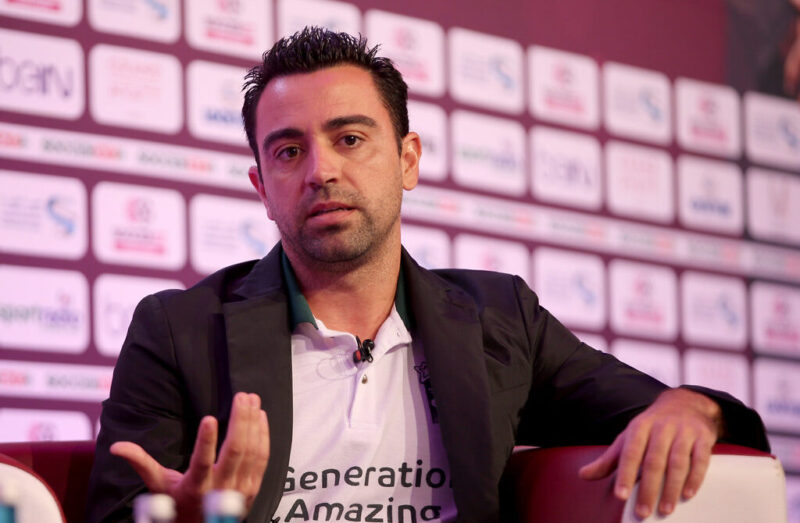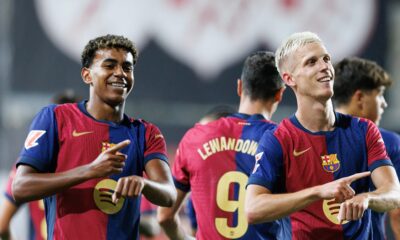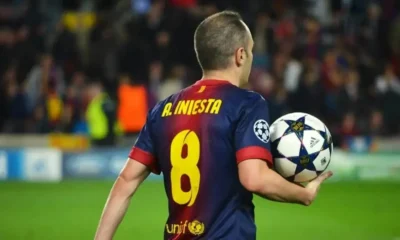Football
Tactical analysis of Barcelona or How Xavi transformed the Catalan team in his image
More than four months ago, Barcelona was deep in crisis. Apart from finances, the club was also struggling with its performance on the pitches under Ronald Koeman. This led to a long called for change and the return of Catalan legend Xavi Hernandez. What are the results of his work?

More than four months ago, Barcelona was deep in crisis. Apart from finances, the club was struggling with its performance on the pitch under Ronald Koeman. This led to a long called for change and the return of Catalan legend Xavi Hernandez. What are the results of his work?
Xavi left Barcelona at his best as a fresh Champions League winner and returned during its disintegration. He has now been trying to stop it for over four months and so far has been successful. He took over the club after a run of six league games with only one win. He now has eleven with three draws and a single defeat.
The Catalan club moved up five places and after the victory over Atlético Madrid, Barcelona finally looked among the top four after 20 rounds. With what tactics did Xavi achieve such a rapid improvement?
The basic ideology
Xavi prides himself on great dominance especially when playing with the ball. It’s not about keeping it on the ball for as long as possible, but using it effectively and getting it back quickly after losing it. His charges must be technically excellent and able to play combination football in small, tight spaces.
At the same time, they must be able to use their own movement to make the pitch bigger and gain space to create chances. When playing on the ball, the aim is to make the pitch as wide and long as possible and vice versa when defending.
Xavi is also aware of the great quality that Barcelona’s youth holds. Thus, he tries to build the team on promising youngsters like Gavi or Pedri, as well as on the experienced Pique or Alves, whom he brought back from South America. These matadors can give the youngsters a lot of experience both on and off the pitch.
Barcelona’s line-up
Now to the specific tactical side of Xavi’s Barcelona. The players play in a 4-3-3 formation, whose personnel has settled in recent matches on the defensive foursome of Alba – Piqué – Araújo – Alves, the midfield of De Jong – Busquets – Pedri and the attacking trio of Gavi – Torres – Adama.
One of the most important instructions is who will hold the width of the pitch, and just from the line-up it can be easily deduced. While on the right side it will be Adama, a typical winger great at dribbling and quick centres, on the left it will be Alba, a far back.
This of course affects the roles of others in the team. Barcelona form a 2-3-5 formation in the opponent’s half, with Adama and Alba being the wingers. So to complete the attacking five, Gavi will move out from the left wing into the space between the left-back and striker Torres.
On the right side, Pedri gets in between. Alves thus joins the midfield as an inverted fullback, where he complements Busquets and de Jong.
Transition phase
In midfield, Barcelona’s system remains as on paper in the 4-3-3 formation and in personnel. Both stoppers will be spread out and ter Stegen will form a tracking trio with them. The two outside backs will remain at the lines, as will the wingers. Busquets figures in the pivot role, while one of the other two midfielders mostly stays a little higher up, able to react to any kick.
The attacking trio can keep the entire defensive four busy with their stretching, and so underneath them, together with the goalkeeper, there is an 8-on-6 outnumbering which Barcelona exploit in the midfield.
Most teams in the Iberian Peninsula, however, prefer to wait in the low or midfield block, so Barcelona are much more likely to get into the transition phase only in the advanced areas of the pitch and with different instructions.
In particular, the left side and the rotation there is very important. Everything with its movement often starts with Gavi, who will withdraw from the wing more to the middle and thus usually pull down the opponent’s outside midfielder. Alba will then run into the space created at the line, taking the opponent’s winger with him and freeing up a large space to the left of the stopper with the ball.
There, de Jong runs in and is in charge of much of the transition phase, and this rotation helps him gain more time. This is because before the defenders pass the ball to each other, de Jong can calmly turn with the ball, scan the space and find the recipient of his next pass.
However, a kick behind the defence is often an option for Alba, who charges into the space behind the opposing right-back. Of course, Gavi can also be the recipient of the pass, as he is between the opponent’s disjointed lines.
However, de Jong’s movement means Barcelona lose a player in the middle of the park, often the response of Alves, who moves into midfield alongside Busquets. Barcelona’s midfield and defence thus works very similarly to that of, say, Arsenal.
Whenever de Jong retreats to the fullbacks, Alves steps up to Busquets in midfield and vice versa. Thus, they are constantly in a 3-2 shape while rotating and confusing the opponent. Then when the ball gets forward, they both join the midfield.
At Arsenal, the role of Alves is filled by Tomiyasu, who is slightly more passive and more often part of the stopper trio. De Jong’s position at Arsenal is held by Xhaka.
Playing in the opponents’ half
As I mentioned before, in the opponent’s half, Barcelona form a 2-3-5 system. One of its biggest strengths is the attacking five, which outnumbers the opposition’s defensive four. So when the centre of gravity of the game is on one side, the defence has to move quickly, leaving space for players on the far side.
Barcelona take advantage of this extensively, with players often withdrawing in large numbers to the left side, where they combine in the small congested space. The main effect is to pull the opposition defence to one side of the pitch and free up the other.
Traoré is the only one who stays on the wing and waits for a long cross. He then has plenty of space to dribble and then centre into the box, where Barcelona’s four remaining players from the original attacking five charge in.
This is just one of the few templates though, the players tend to come up with their own solutions to situations while having a lot of freedom in movement and rotations, which especially take place on the left side between Alba, Gavi and de Jong. On the right side, Pedri and Alves rotate mostly, as Adama is not technical enough to get involved in the combination in the middle of the pitch.
Presink
Barcelona’s attack is very much geared towards personal defending. The striker is in charge of one of the stoppers and one of the midfielders takes the other. The others are then taken apart personally by the rest of the team, so the formation usually looks like a 4-4-2.
Summary
Xavi has given Barcelona back a vision and a clear-cut philosophy, which moreover coincides with the Catalan tradition of combination football. However, he still needs to gain a lot of experience at the highest level and so do a large part of his charges.
I see one of the drawbacks of his system as the use of Pedri, who doesn’t excel that much in a more offensive role. If I’m exaggerating, for this position Barcelona need more of an Antonín Barák type midfielder who is comfortable in the box and is more of a goalscorer. Pedri, on the other hand, I see as more of a withdrawn playmaker.
Source: FC Barcelona, Tactical Board










